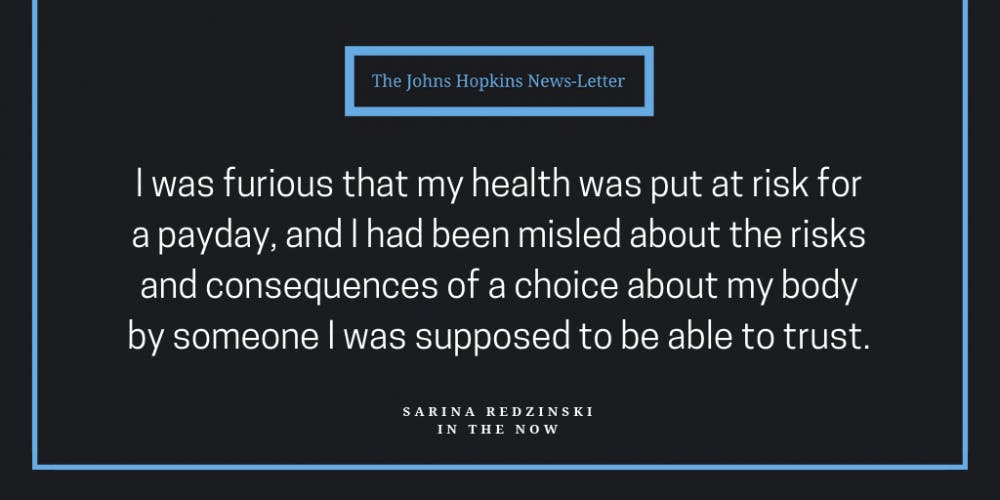
My junior year, I decided to try birth control.
Predictably, sexual health is often not addressed in booklets and presentations prepping kids to go off on their own. Things like birth control and physical exams are assumed to fall under the umbrella of general student health services.
Students are essentially expected to just figure it out on their own, so, like most people, I turned to the internet.
Scared of adjusting to the pill after a negative experience, I researched other options. That’s when I found Nexplanon. There was practically no maintenance, the process for insertion and removal seemed simple and there was even the possibility that I’d stop getting my period altogether.
Unfortunately, when I went to the school health center’s website, I realized that I couldn’t get Nexplanon here unless I was on the school’s health insurance (which I wasn’t). So, I had to find a new OBGYN.
I found a highly rated doctor in the area who couldn’t praise the implant enough. She mentioned that I might experience some bruising at the insertion site and that my period could become irregular, but she stressed that if I reacted negatively or didn’t like it, removal would be quick and easy. Excited about taking control of my sexual health, I decided to get the implant.
Insertion was mostly fast and painless, the most uncomfortable part being the numbing shot.
After sliding a device akin to an ear piercing gun into my arm, the doctor lifted my skin up, shot the implant in, then slid the device back out. Within the span of only about twenty minutes, the doctor wrapped my arm up (tightly) and sent me home.
Once the numbing agent wore off my arm started to hurt. The next day, when I took the bandage off, I could clearly see where the implant was. It had created a deep reddish-purple, hourglass-shaped bruise and was pretty swollen. It was jarring to look at, especially as it healed and the bruise spread to be five or six inches in length.
But bad bruising isn’t unusual for me, so I rode it out, though I had to skip work and class one day because of radiating pain.
While it ended up healing well, the next four months were some of the toughest of my life. My mood changed drastically — I was pessimistic, easily overwhelmed and often irritable. I would go from horrible rage to hysterical crying out of nowhere, sobbing alone almost every night.
To make matters worse, I had my period or spotting consistently for almost two months. This made me exhausted all the time. I isolated myself from my friends, unable to leave my room, and for the first time in two years, I had a panic attack.
Though I broke up with my boyfriend and felt my first small sigh of relief in months, even that reprieve was temporary. I was scared and I just wanted to go home.
When break finally came, I tried using the NuvaRing for the bleeding. It seemed to calm my system down a bit and help with my period, but my mood swings were still intense despite being away from school.
That’s when my mother and I had discussed finding someone to take out my implant. Without anything else to blame my tumultuous emotions on, I was faced with the truth that Nexplanon was probably the cause of all this.
The two OBGYNs I visited while home in New Jersey immediately knew what was going on. They both expressed their hatred of the implant, which surprised me after hearing such great things from my OBGYN in Baltimore.
Luckily, one doctor I visited said she could take it out. I was so happy I could’ve cried, sitting there in that itchy office chair being told someone was willing to get rid of this thing.
After a short surgical procedure in which she numbed my arm then made a small cut at the top of the implant and pushed it out, I went home to heal.
But that wasn’t the end. As my hormones struggled to regulate without the implant, I actually felt worse. I was depressed and unable to motivate myself. Just getting out of bed was almost physically painful. It took about a month for this to improve.
Throughout that month, though the wound closed up, my arm still hurt, and my self esteem plummeted as I became entirely out of touch with my body and mind — I felt like I had betrayed myself and was constantly bothered by guilt.
Things are better now. Though it took a little while for me to restore my body image and self-confidence, I can safely say I feel like myself again. The only reminders I have left of Nexplanon are the two small scars it left behind.
I didn’t want to write this piece to scare other people away from Nexplanon. I know there are people out there who love their implant and who have had great experiences with it. I don’t think that my experience in any way invalidates their stories. Because birth control is a highly personal and individual thing, there’s no way to truly know beforehand how your body is going to react.
One night, while looking for a documentary to watch, I came upon Netflix’s The Bleeding Edge, which is about implanted medical devices. At the end of the documentary, they suggest going to the website openpaymentsdata.cms.gov and looking up your doctor to see if they are being paid by any companies that own or manufacture medical devices.
I searched my Baltimore OBGYN and found that she had been paid almost $70,000 by the company that owns Nexplanon.
Upon discovering this, I was furious that my health was put at risk for a payday, and I had been misled about the risks and consequences of a choice about my body by someone I was supposed to be able to trust. But even more than all that, I was furious for the people who had it much, much worse than I, whether with Nexplanon or another birth control device.
I think a lot of people don’t want to speak up about their experiences because it can come across as anti-sex-positive or anti-birth control. But here’s the truth: You cannot take control of your life and your body if you’re not being told the true risks associated with your options. Nexplanon and other products like it are marketed as empowering, but there are few other times in my life when I have felt so powerless.
So I hope this piece helps anyone with a vagina who may consider trying one of these devices. We need to be thorough, and we need to pay more attention to those cautionary tales online that are billed as uncommon bad reactions. We need to look into who is paying our doctors.
There are so many options for birth control, so we have to make sure we’re choosing the option that is best for each of us as individuals, not what’s best for a doctor or company. We have to take care of ourselves and our bodies, because, unfortunately, oftentimes no one else will.
If you’re considering consulting your OBGYN about birth control, I hope you’ll check out your doctor on the payment website and weigh all of your options carefully so you can avoid going through something like I did.





